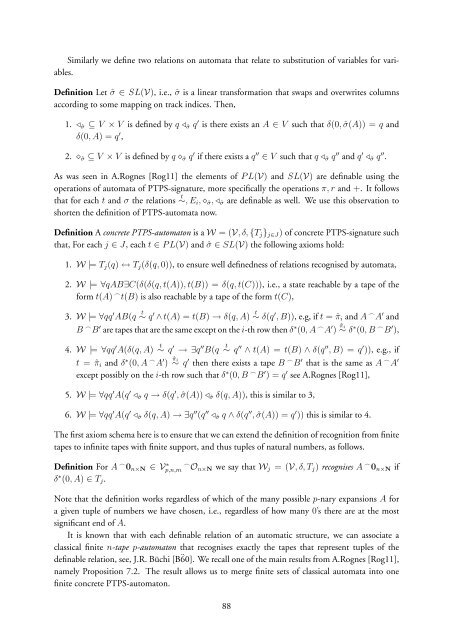On the methods of mechanical non-theorems (latest version)
On the methods of mechanical non-theorems (latest version)
On the methods of mechanical non-theorems (latest version)
You also want an ePaper? Increase the reach of your titles
YUMPU automatically turns print PDFs into web optimized ePapers that Google loves.
Similarly we define two relations on automata that relate to substitution <strong>of</strong> variables for variables.<br />
Definition Let ˆσ ∈ SL(V), i.e., ˆσ is a linear transformation that swaps and overwrites columns<br />
according to some mapping on track indices. Then,<br />
1. ⊳ˆσ ⊆ V × V is defined by q ⊳ˆσ q ′ is <strong>the</strong>re exists an A ∈ V such that δ(0, ˆσ(A)) = q and<br />
δ(0, A) = q ′ ,<br />
2. ⋄ˆσ ⊆ V × V is defined by q ⋄ˆσ q ′ if <strong>the</strong>re exists a q ′′ ∈ V such that q ⊳ˆσ q ′′ and q ′ ⊳ˆσ q ′′ .<br />
As was seen in A.Rognes [Rog11] <strong>the</strong> elements <strong>of</strong> P L(V) and SL(V) are definable using <strong>the</strong><br />
operations <strong>of</strong> automata <strong>of</strong> PTPS-signature, more specifically <strong>the</strong> operations π, r and +. It follows<br />
that for each t and σ <strong>the</strong> relations t ∼, E i , ⋄ˆσ , ⊳ˆσ are definable as well. We use this observation to<br />
shorten <strong>the</strong> definition <strong>of</strong> PTPS-automata now.<br />
Definition A concrete PTPS-automaton is a W = (V, δ, {T j } j∈J ) <strong>of</strong> concrete PTPS-signature such<br />
that, For each j ∈ J, each t ∈ P L(V) and ˆσ ∈ SL(V) <strong>the</strong> following axioms hold:<br />
1. W |= T j (q) ↔ T j (δ(q, 0)), to ensure well definedness <strong>of</strong> relations recognised by automata,<br />
2. W |= ∀qAB∃C(δ(δ(q, t(A)), t(B)) = δ(q, t(C))), i.e., a state reachable by a tape <strong>of</strong> <strong>the</strong><br />
form t(A) ⌢ t(B) is also reachable by a tape <strong>of</strong> <strong>the</strong> form t(C),<br />
3. W |= ∀qq ′ AB(q t ∼ q ′ ∧ t(A) = t(B) → δ(q, A) t ∼ δ(q ′ , B)), e.g, if t = ˆπ i and A ⌢ A ′ and<br />
B ⌢ B ′ are tapes that are <strong>the</strong> same except on <strong>the</strong> i-th row <strong>the</strong>n δ ∗ (0, A ⌢ A ′ ) ˆπ i<br />
∼ δ ∗ (0, B ⌢ B ′ ),<br />
4. W |= ∀qq ′ A(δ(q, A) t ∼ q ′ → ∃q ′′ B(q t ∼ q ′′ ∧ t(A) = t(B) ∧ δ(q ′′ , B) = q ′ )), e.g., if<br />
t = ˆπ i and δ ∗ (0, A ⌢ A ′ ) ˆπ i<br />
∼ q ′ <strong>the</strong>n <strong>the</strong>re exists a tape B ⌢ B ′ that is <strong>the</strong> same as A ⌢ A ′<br />
except possibly on <strong>the</strong> i-th row such that δ ∗ (0, B ⌢ B ′ ) = q ′ see A.Rognes [Rog11],<br />
5. W |= ∀qq ′ A(q ′ ⊳ˆσ q → δ(q ′ , ˆσ(A)) ⊳ˆσ δ(q, A)), this is similar to 3,<br />
6. W |= ∀qq ′ A(q ′ ⊳ˆσ δ(q, A) → ∃q ′′ (q ′′ ⊳ˆσ q ∧ δ(q ′′ , ˆσ(A)) = q ′ )) this is similar to 4.<br />
The first axiom schema here is to ensure that we can extend <strong>the</strong> definition <strong>of</strong> recognition from finite<br />
tapes to infinite tapes with finite support, and thus tuples <strong>of</strong> natural numbers, as follows.<br />
Definition For A ⌢ 0 n×N ∈ V ∗ p,n,m ⌢ O n×N we say that W j = (V, δ, T j ) recognises A ⌢ 0 n×N if<br />
δ ∗ (0, A) ∈ T j .<br />
Note that <strong>the</strong> definition works regardless <strong>of</strong> which <strong>of</strong> <strong>the</strong> many possible p-nary expansions A for<br />
a given tuple <strong>of</strong> numbers we have chosen, i.e., regardless <strong>of</strong> how many 0’s <strong>the</strong>re are at <strong>the</strong> most<br />
significant end <strong>of</strong> A.<br />
It is known that with each definable relation <strong>of</strong> an automatic structure, we can associate a<br />
classical finite n-tape p-automaton that recognises exactly <strong>the</strong> tapes that represent tuples <strong>of</strong> <strong>the</strong><br />
definable relation, see, J.R. Büchi [B¨60]. We recall one <strong>of</strong> <strong>the</strong> main results from A.Rognes [Rog11],<br />
namely Proposition 7.2. The result allows us to merge finite sets <strong>of</strong> classical automata into one<br />
finite concrete PTPS-automaton.<br />
88
















